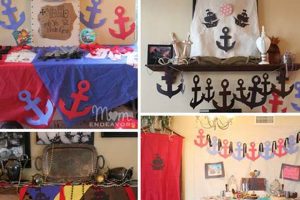The creation of adornments for the Diwali festival, utilizing a do-it-yourself approach, represents a fusion of tradition and individual expression. This involves crafting festive ornaments, often from readily available or repurposed materials, to embellish homes and spaces during the celebration of light. A simple example includes constructing paper lanterns or painting diyas (oil lamps) with intricate designs.
Engaging in the practice allows for a personalized celebration reflecting individual creativity and resourcefulness. Beyond the aesthetic enhancements, this activity fosters a deeper connection to the cultural significance of Diwali, promoting engagement with familial traditions and artistic skill development. Historically, homemade embellishments were commonplace due to resource constraints, evolving into a cherished practice that emphasizes community involvement and mindful consumption.
The following sections will explore a diverse range of projects suitable for creating celebratory ambiance, encompassing both traditional and contemporary design elements. This includes guidance on material selection, step-by-step instructions, and tips for optimizing the visual impact of these self-made adornments.
Essential Guidelines for Crafting Diwali Embellishments
The following guidelines aim to optimize the visual appeal and longevity of self-made decorations for the Diwali festival, while promoting safety and responsible resource management.
Tip 1: Prioritize Fire Safety: When working with diyas or candles, ensure a secure and stable base is used to prevent accidental tipping. Maintain a safe distance from flammable materials such as curtains, paper decorations, and fabrics. Never leave lit diyas unattended.
Tip 2: Source Sustainable Materials: Opt for recycled paper, repurposed fabrics, and natural elements like leaves and flowers whenever possible. This reduces environmental impact and adds an authentic, earthy touch to the decorations. Minimize the use of plastics and non-biodegradable materials.
Tip 3: Plan a Cohesive Color Palette: Establish a consistent color scheme throughout the decorations. This creates a unified and visually appealing aesthetic. Traditional Diwali colors such as gold, red, and orange can be combined with complementary hues like green or blue for a sophisticated look.
Tip 4: Incorporate Traditional Motifs: Utilize classic Indian patterns and symbols like rangoli designs, lotus flowers, and paisley patterns. These motifs connect the decorations to the cultural heritage of Diwali, enhancing their symbolic significance.
Tip 5: Ensure Proper Illumination: Adequate lighting is crucial for showcasing decorations effectively. Supplement diyas and candles with string lights or LED lamps to create a warm and inviting ambiance. Consider using solar-powered lights for outdoor displays to conserve energy.
Tip 6: Secure Decorations Properly: Ensure all decorations are securely attached to surfaces to prevent them from falling or being dislodged by wind or accidental contact. Use strong adhesives, hooks, or ties that are appropriate for the materials being used.
Tip 7: Involve Family and Friends: The crafting process should be a collaborative effort, fostering a sense of community and shared celebration. Assign tasks based on skill levels and interests, encouraging everyone to contribute their unique talents.
These guidelines emphasize safety, sustainability, and aesthetic coherence, ensuring that self-made decorations enhance the festive atmosphere of Diwali while adhering to responsible practices.
The concluding section will provide specific project ideas, showcasing a range of techniques and styles for creating impactful Diwali adornments.
1. Creativity
Creativity forms the cornerstone of personalized Diwali embellishments, serving as the impetus for innovative design and resource adaptation. Its presence transforms functional decoration into a medium for personal expression and cultural reimagining. For example, using discarded glass bottles as the base for intricate painted diyas or transforming old saris into vibrant torans demonstrates how inventive resourcefulness can elevate commonplace items to artistic expressions of celebration.
The absence of creative input leads to standardized, mass-produced decorations, devoid of individual character. The effective integration of ingenuity, conversely, fosters a deeper emotional connection to the holiday and its meaning. Consider the impact of handcrafted rangoli patterns designed with unique color combinations and unconventional materials. These adaptations showcase individuality while adhering to the core principles of the art form.
Therefore, creativity is not merely an aesthetic enhancement but a practical imperative in crafting Diwali adornments. It promotes resourcefulness, encourages personal expression, and strengthens the bond between individuals and the festive traditions, enriching the overall celebration through unique and meaningful designs.
2. Sustainability
The intersection of sustainability and crafting homemade Diwali decorations addresses the environmental impact associated with mass-produced, commercially available alternatives. The conventional supply chain for such goods often involves resource depletion, extensive transportation, and the generation of waste. A consequence of prioritizing sustainability within the realm of self-made Diwali adornments is the reduction of this environmental footprint through practices such as upcycling, utilizing biodegradable materials, and minimizing the consumption of new resources. For instance, crafting lanterns from recycled paper or transforming old glass jars into decorative candle holders exemplifies the practical application of sustainable principles.
The importance of sustainability as a component of crafting homemade Diwali ornaments lies in its contribution to responsible consumption and waste reduction. This involves conscious material selection, favoring eco-friendly options like natural dyes, bamboo, or locally sourced flowers. Practical significance is demonstrated by the reduced landfill burden and the conservation of natural resources. Moreover, sustainable practices often translate to cost savings, as repurposed materials are typically less expensive than newly purchased items. The use of discarded fabrics for creating colorful wall hangings or the transformation of plastic bottles into decorative light fixtures provides tangible evidence of this economic benefit.
In summary, embracing sustainability in the creation of Diwali decorations presents a viable strategy for mitigating the environmental consequences associated with conventional commercial products. This approach encourages responsible resource management, reduces waste generation, and promotes a more environmentally conscious celebration. Challenges may include sourcing suitable sustainable materials and adopting new crafting techniques. However, the integration of sustainability into the festive preparations aligns with the broader movement towards environmental responsibility, fostering a harmonious balance between cultural traditions and ecological stewardship.
3. Personalization
Personalization is a central tenet when engaging in the practice. It allows individuals and families to imbue their celebrations with unique character and meaning. The cause-and-effect relationship is clear: self-created decorations offer unparalleled opportunities for customized design, whereas commercially produced items are inherently standardized. The importance of personalization stems from its ability to strengthen emotional connections to the festival, transforming decorative elements from mere ornamentation into representations of individual and collective identity. Real-life examples include families incorporating specific color palettes that resonate with their cultural heritage, or children contributing their artwork to create bespoke wall hangings. The practical significance of this understanding lies in its capacity to elevate the festive atmosphere from a generic observance to a deeply personal experience.
Furthermore, the practical application of personalization extends beyond mere aesthetic choices. It can involve incorporating elements that reflect personal values, such as using repurposed materials to demonstrate environmental consciousness, or crafting decorations inspired by family heirlooms to honor ancestral traditions. The integration of personalized touches contributes to a sense of ownership and pride in the celebratory display. For instance, creating a custom rangoli pattern that incorporates family members’ names or crafting diyas with symbols that represent shared values are tangible ways to implement personalization. This tailored approach not only enhances the visual appeal of the decorations but also fosters a deeper sense of belonging and connection to the cultural significance of Diwali.
In summary, personalization is an indispensable aspect when it comes to diwali decorations diy. It enables a more meaningful and engaging celebration. The challenges associated with personalization are often minimal, typically involving time investment and creative exploration. Linking to the broader theme of cultural preservation and individual expression, personalization reinforces the notion that traditions are not static entities but are continually shaped and enriched by the contributions of each generation. This approach ensures that celebrations remain vibrant, relevant, and deeply connected to the lives of those who participate.
4. Tradition
Tradition serves as a foundational pillar for self-made Diwali embellishments, shaping both the aesthetics and the underlying meaning of these decorative efforts. The connection between traditional motifs and do-it-yourself projects provides a tangible link to cultural heritage, grounding the festivities in established customs and practices. The incorporation of these traditional elements serves to enrich the overall experience and reinforce the symbolic significance of the celebration.
- Rangoli Designs
Rangoli, an art form involving intricate patterns created on the ground using colored powders, holds significant traditional importance. Its inclusion in decorations provides a visual representation of auspiciousness and welcome. DIY rangoli allows for creative interpretation while adhering to traditional motifs such as geometric patterns, floral designs, and depictions of deities. Deviation from traditional patterns risks losing the cultural significance of the art form.
- Diyas (Oil Lamps)
Diyas symbolize the triumph of light over darkness, a central theme of Diwali. Their presence is indispensable to traditional Diwali celebrations. Self-made diyas, whether crafted from clay or repurposed materials, retain this symbolic value while allowing for personal expression through painting and embellishment. Commercial alternatives, though convenient, may lack the handcrafted touch that connects the decorations to the spirit of the festival.
- Torans (Door Hangings)
Torans, traditionally hung above doorways, are believed to ward off evil spirits and invite prosperity. They often incorporate symbols like mango leaves, marigolds, and depictions of deities. DIY torans offer an opportunity to engage with traditional crafting techniques, such as embroidery or beadwork, while adapting the design to personal preferences. The absence of traditional symbols in a toran diminishes its intended purpose.
- Use of Natural Materials
Historically, decorations relied heavily on readily available natural materials like flowers, leaves, and fruits. The use of these elements connects the festivities to the natural world and reflects a sense of gratitude for the harvest. Incorporating natural materials into self-made decorations, such as garlands of marigolds or arrangements of mango leaves, upholds this traditional practice. The substitution of synthetic materials diminishes this connection to nature and may detract from the authenticity of the decorations.
These facets of tradition, when integrated into self-made Diwali adornments, contribute to a richer and more meaningful celebration. By understanding and respecting the historical and symbolic significance of these elements, individuals can create decorations that not only enhance the visual appeal of their homes but also strengthen their connection to the cultural heritage of Diwali. Ignoring these traditions diminishes the significance of the celebration turning it into something far from the meaning behind Diwali
5. Cost-Effectiveness
The pursuit of cost-effectiveness forms a significant motivator for engaging in “diwali decorations diy”. A direct causal relationship exists between the selection of self-made decorations and the potential reduction in expenditure compared to purchasing commercially produced alternatives. The importance of cost-effectiveness as a component of this practice stems from its capacity to make festive celebrations accessible to a broader segment of the population, particularly those with budgetary constraints. Real-life instances involve families utilizing repurposed materials like old newspapers, fabric scraps, and glass jars to create lanterns, wall hangings, and diyas, respectively. The practical significance of this understanding lies in its ability to demonstrate how resourcefulness can transform readily available, low-cost materials into aesthetically pleasing and culturally relevant adornments.
Furthermore, the practical application of cost-effective decorating strategies involves careful planning and prioritization. This includes conducting a thorough inventory of existing materials before purchasing new ones, exploring bulk discounts on essential supplies, and focusing on projects that maximize visual impact while minimizing material costs. For example, creating intricate rangoli designs using readily available colored rice or using simple paper cutouts to adorn windows exemplifies cost-conscious decorating approaches. The integration of these strategies not only reduces financial burden but also encourages creativity and resourcefulness, fostering a sense of accomplishment in crafting unique decorations. The challenge may come in the time and effort required in crafting those pieces. However, the cost saving from those store bought decorations can be enormous, for example you could make 10-20 paper lanterns for the price of one from the shop.
In summary, cost-effectiveness is a key driver for participating in “diwali decorations diy”, enabling individuals and families to celebrate the festival without incurring substantial expenses. By leveraging readily available resources, adopting resource-saving strategies, and prioritizing creativity over commercial purchases, individuals can create festive decorations that are both aesthetically pleasing and financially sustainable. This aligns with the broader theme of resourcefulness and community engagement, reinforcing the notion that meaningful celebrations need not be extravagant to be culturally significant.
6. Community
The collaborative nature of creating Diwali embellishments cultivates a sense of shared purpose and strengthens interpersonal bonds. This communal effort fosters a deeper connection to both the festival and the individuals involved.
- Shared Crafting Sessions
Organized crafting sessions bring together neighbors, friends, and family members to collectively produce Diwali decorations. These gatherings provide opportunities for skill-sharing, collaborative problem-solving, and the transmission of traditional crafting techniques. The act of working together fosters camaraderie and strengthens social ties, transforming the creation process into a shared cultural experience. Practical examples include community centers hosting lantern-making workshops or neighborhood groups assembling torans for communal display.
- Intergenerational Knowledge Transfer
Engaging in do-it-yourself decoration projects facilitates the transfer of cultural knowledge from older to younger generations. Elders often possess expertise in traditional crafting methods and can guide younger participants in the creation of authentic decorations. This intergenerational exchange preserves cultural heritage and fosters a sense of continuity and belonging. Real-world instances involve grandparents teaching grandchildren how to create intricate rangoli patterns or mothers passing down the techniques for embroidering decorative wall hangings.
- Collaborative Displays and Installations
Community-based Diwali celebrations often feature collaborative displays and installations showcasing self-made decorations. These communal efforts create a sense of shared ownership and pride in the festive ambiance. The act of contributing to a larger collective display promotes community cohesion and strengthens social bonds. Examples include neighborhoods collectively decorating streets with handmade lanterns or community centers organizing exhibitions featuring self-made Diwali artwork.
- Resource Sharing and Bartering
The practice of crafting Diwali decorations often involves the sharing of resources and bartering of skills within a community. Neighbors may exchange materials, tools, or expertise to facilitate the decoration process. This reciprocal exchange fosters a sense of mutual support and strengthens community bonds. Practical scenarios involve neighbors lending crafting tools to one another or exchanging surplus materials like fabric scraps or colored powders. This sharing not only reduces individual expenses but also promotes collaboration and resourcefulness.
These community-driven aspects of diwali decorations diy transform the act of creating decorations from an individual endeavor into a collective expression of cultural identity and social connection. By engaging in shared crafting sessions, facilitating intergenerational knowledge transfer, creating collaborative displays, and sharing resources, communities can strengthen social bonds, preserve cultural heritage, and foster a deeper sense of belonging during the Diwali festival. Thus promoting the feeling of togetherness and a mutual sense of pride during the Diwali season.
Frequently Asked Questions
This section addresses common inquiries regarding the crafting of adornments for the Diwali festival, utilizing a do-it-yourself approach. The answers provide concise and informative guidance.
Question 1: What materials are best suited for creating diyas?
Traditional diyas are crafted from clay due to its heat resistance and biodegradability. However, alternatives include repurposed glass jars or metal containers. The selection should prioritize fire safety and stability.
Question 2: How can fire safety be ensured when using diyas and candles?
Diyas and candles require a stable base to prevent accidental tipping. Flammable materials such as curtains and paper decorations must be kept at a safe distance. Unattended flames pose a significant hazard and should be avoided.
Question 3: What are some sustainable options for Diwali decorations?
Sustainable options include recycled paper, repurposed fabrics, and natural elements like flowers and leaves. Minimizing the use of plastics and non-biodegradable materials is recommended.
Question 4: How can traditional motifs be incorporated into diy projects?
Traditional Indian patterns and symbols like rangoli designs, lotus flowers, and paisley patterns can be stenciled, painted, or embroidered onto various decorations. These motifs enhance the cultural significance of the adornments.
Question 5: What is the best way to create a cohesive color scheme for Diwali decorations?
Establishing a consistent color palette, often incorporating traditional Diwali colors such as gold, red, and orange, creates a unified and visually appealing aesthetic. Complementary hues can be added for visual interest.
Question 6: How can the longevity of self-made decorations be increased?
Protecting decorations from moisture and direct sunlight extends their lifespan. Using durable materials and secure fastening methods also contributes to their longevity.
These FAQs offer practical insights into the creation of impactful Diwali adornments.
The concluding section will summarize key takeaways and outline directions for further exploration.
Conclusion
The preceding analysis has explored the multifaceted aspects of diwali decorations diy, underscoring the convergence of creativity, sustainability, personalization, tradition, cost-effectiveness, and community engagement within this practice. The significance of these elements in enhancing the festive ambiance and fostering a deeper connection to cultural heritage has been established through practical examples and detailed explanations. This exploration emphasizes the importance of thoughtful planning and responsible execution in crafting meaningful and aesthetically pleasing adornments.
The enduring relevance of self-created embellishments for the Diwali festival lies in their capacity to transform a commercialized celebration into a personalized expression of cultural identity. The continued exploration and refinement of these practices will ensure the preservation and evolution of this cherished tradition. Future endeavors should focus on fostering greater community involvement, promoting sustainable material sourcing, and encouraging innovative design approaches to further enrich the cultural significance of Diwali celebrations. The emphasis on diy decorations should remain a staple practice within families to reinforce the celebration for years to come.







